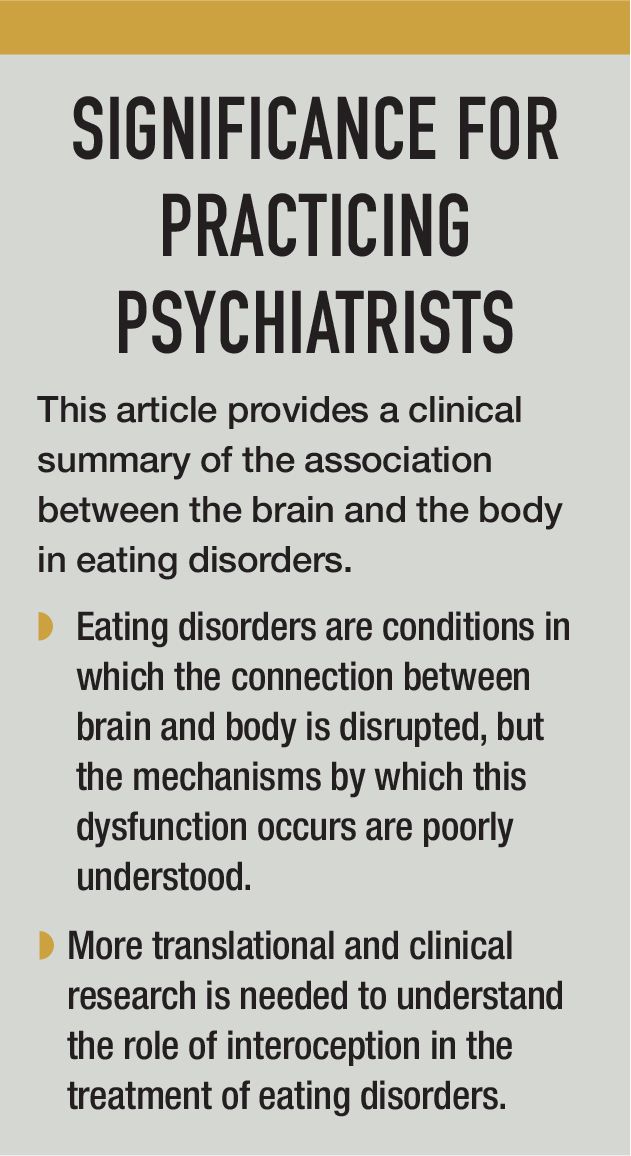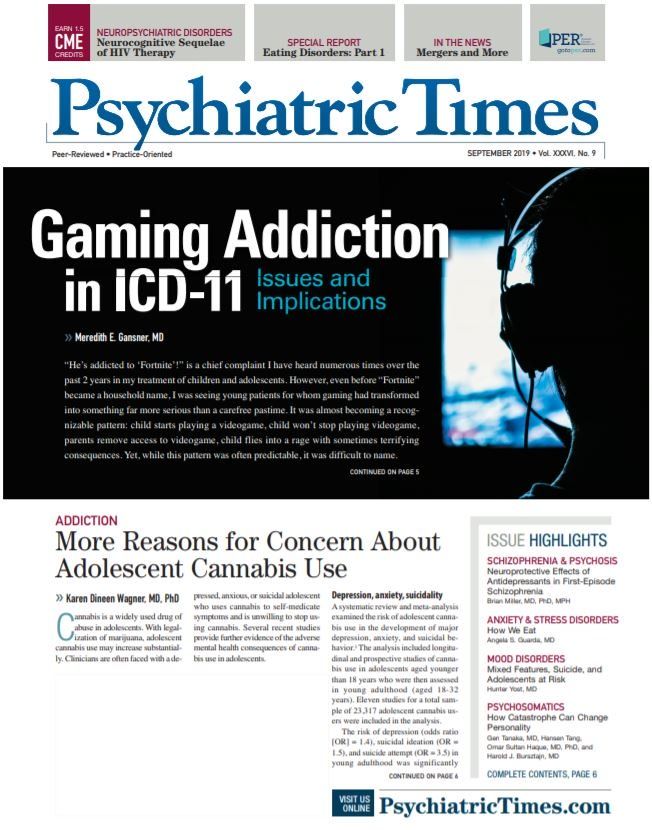Publication
Article
Psychiatric Times
Interoception in Eating Disorders: A Clinical Primer
Author(s):
More than two-thirds of patients with eating disorders also have comorbid mood and anxiety disorders. This article considers how a transdiagnostic process called interoception may help to advance our understanding and treatment of eating disorders.
©Goodluz/Shutterstock

SIGNIFICANCE FOR PRACTICING PSYCHIATRISTS

INTEROCEPTION: the process by which the nervous system senses, interprets, and integrates cascades of these signals from within the body in order to maintain homeostasis.1
INTEROCEPTION AWARENESS: the act of consciously sensing, interpreting, and integrating information about the state of inner body systems.
More than two-thirds of patients with eating disorders also have comorbid mood and anxiety disorders.2 This suggests that the current system of symptom-based diagnosis incompletely identifies the underlying pathophysiological mechanisms driving these illnesses. This article considers how a transdiagnostic process called interoception may help to advance our understanding and treatment of eating disorders.
Overview of interoception
Consider for a moment the fact that every day our brains interpret sensory signals from the body in order to keep us out of harm’s way. The most common form of these signals relates to our ability to see predators looming in the distance, to hear them creeping up in the shadows, or to perhaps simply smell and avoid a poisonous piece of food. While the visual, auditory, and olfactory systems are clearly critical for survival, our brains are also constantly tracking a completely different world of sensory signals-ones originating from within our bodies.
Interoceptive sensory signals arising from the gastrointestinal, cardiovascular, respiratory, urogenital, hormonal, osmotic, glycemic, and acidotic systems are each in their own way critical to survival. What would happen if you were unable to sense when your blood sugar was low-how would you know whether you were hungry? Would you rely on others to notice a change in your behavior, such as irritability? If you were alone, would you suffer in silence? How would you survive? What if you could not detect the feeling of thirst? Sensing whether it is time to eat, drink, sleep, or excrete waste are daily rhythms that we engage in almost unconsciously. But not so for patients with eating disorders. Disrupted interoceptive awareness may negatively impact the mental health of individuals affected by eating disorders.
Interoception in anorexia nervosa
Individuals with anorexia nervosa (AN) display a remarkable ability to ignore hunger cues and to maintain the body in a state of self-starvation, despite clamorous signaling from peripheral orexigenic hormones such as ghrelin.3 Contrary to usual settings, the corrective action of eating is experienced aversively by these patients, as evidenced by the fact that they report heightened fears at the prospect of eating a meal and assiduously avoid situations involving food.4 Individuals with AN show a dysfunctional processing of interoceptive signals during premeal periods, as evidenced by a heightened experience of sympathetically mediated symptoms such as palpitations and dyspnea.5 They also show abnormal brain activity in areas important for interoceptive processing.
Acutely underweight patients show reduced functional connectivity in a brain network centered around the insular cortex, a region that is the primary cortical recipient of interoceptive signals relayed through the brainstem and thalamus.6 Weight restored patients exhibit greater insula activation in association with stomach sensations, but the opposite relationship happens in the amygdala, highlighting the potential role of negative affect in the body sensing process.7
Following recovery these individuals exhibit hyperactivation in the insular cortex during the anticipation and resolution of restricted breathing loads (dyspnea) but, surprisingly, not during the loads themselves.8 Patients also abnormally classify taste stimuli-AN and bulimia nervosa patients have reduced insula responses to ingested glucose.9
Taken together, these findings support the general hypothesis that patients with AN make erroneous inferences about internal body sensations in context-specific (eg, food-related) settings. These somatic errors may be key drivers of anxiety expression in the disorder. As clinicians, we can learn much about how these individuals perceive the world by studying the way their brains actively infer meaning about missing or ambiguously perceived interoceptive signals.10
Interoception in bulimia nervosa and binge eating disorder
Interoceptive dysfunction plays an important role in the periods of uncontrolled and disproportionate food ingestion that characterize binge eating, as well as the periods of expulsion that characterize purging. Gastric capacity appears to be increased in bulimia nervosa, and patients with binge eating disorder demonstrate larger meal intake and lower plasma ghrelin than non-binge eaters.11 These findings suggest physical alterations of the gastrointestinal system in both disorders.
Abnormalities of interoceptive processing have been suggested at the neural level in bulimia nervosa, but methodological differences in the available studies limit firm conclusions.12 Even less is known about the effects of purging behaviors on interoception. Further tests that modulate gastrointestinal physiology and measure perceptual responses are needed to improve our understanding of the role of interoception in these disorders.
Developmental importance of interoception in eating disorders
The severe food aversion displayed by individuals with AN often develops during peripubertal periods, which suggests that a complex interplay between hormonal changes and stressful environments contributes to the expression of psychopathology. This has been characterized as a process of abnormal learning involving fear extinction neurocircuitry, one that is driven by reduced or markedly fluctuating levels of estrogen.13 Even less is known about the role of interoceptive dysfunction in this process. From that standpoint, patient observations can sometimes shine a spotlight on areas worth investigating. A recent comment from a patient with an eating disorder during a diagnostic evaluation seems particularly informative.
CASE VIGNETTE
A 20-year-old female reported the onset of AN at age 13, characterized by a 30-lb weight loss over the course of a year and a resulting body mass index of 14.0. Moreover, she was plagued by fears of weight gain, active food avoidance behaviors, and body image disturbance (ie, feeling fat) despite her weight loss. When recalling her initial experience of symptoms, she stated, “I would lie in bed feeling like I was suffocating. I could feel the weight on my ribs and I felt like it was suffocating me. I was sure it was anxiety, but I just felt like I was going to die from the weight I was gaining.”
Beyond food-associated discomfort, the fact that anxiety and suffocation fears were distinctly remembered as a key to the onset of her disorder emphasizes the importance of comorbid anxiety and leads to speculation whether signals from associated organ systems, such as the respiratory system, might have played a role in the development of her illness.
Assessing interoceptive awareness in eating disorders
In research settings the accuracy of interoceptive sensing is routinely tested; for example, by comparing a person’s actual heartbeat signals against a subjective report of them. Unfortunately, there are currently no clinically validated tests of interoceptive accuracy for gastrointestinal or any other interoceptive sensations. Clinicians can still assess interoceptive awareness in patients with eating disorders during diagnostic assessments by focusing on the constituent elements.
1) Ask patients to describe daily experiences of gastrointestinal, cardiovascular, and respiratory sensations. Are frequent bloating, cramping, palpitations, or dyspnea reported? How often do they focus their attention on these sensations? Is the attentional focus usually goal directed, as in frequent body scanning (top-down), or driven by the emergence of bodily signals (bottom-up)?
2) Where do these sensations occur? Do they incorrectly localize such sensations (eg, too diffusely, or in the wrong area)? Can they learn to correctly locate these sensations?
3) When do these sensations occur? Do they occur only during meal times, or during other notable changes in their external or internal environment? Examining the environmental settings under which these perceptions occur may help improve the understanding of context-specific factors.
4) How intensely do they perceive these sensations? Ask them to rate them on a scale of 0 to 10 (akin to rating the loudness of a speaker volume). Are there particular affective experiences associated with these sensations?
5) To what degree do they feel they are aware of their internal body sensations? Do they self-perceive the tendency to constantly focus on interoceptive signals? How does this attitude affect their eating disorder?
Psychometric assessments of interoceptive awareness are available. The first questionnaire developed to assess interoceptive awareness was the Interoceptive Deficits subscale within the Eating Disorders Inventory, a self-report measure intended to assess eating disorder symptom severity.14 However, only two of the ten items actually assess interoception-related symptoms (eg, confusion about hunger, bloating after small meals), with the remainder of the items preferentially measuring alexithymia (eg, confusion about the emotion being felt).
The Multidimensional Assessment of Interoceptive Awareness questionnaire captures a broader range of interoceptive experiences relevant for clinical settings. It has recently been validated in an eating disorders sample, with body trusting and self-regulation subscales showing the strongest correlations with clinical symptoms.15
Treating dysfunctional interoceptive awareness in eating disorders
One approach that has been suggested to help weaken conditioned associations between interoceptive and environmental cues is interoceptive exposure therapy. Although originally developed for treatment of anxiety, it has been conceptually extended towards eating disorders.16 Using the process of extinction learning, patients are engaged in activities intended to elicit physiological sensations that are disorder-related, associated with negative affective states, and trigger maladaptive behavioral responses.
Patients may be repeatedly confronted with the sight and smell of foods, during which they closely attend to the associated sensations of hunger, salivation, or disgust. Over time, this weakens the conditioned association between the sensory signal and negative affective state, in hopes of reducing food avoidance behaviors.
Consumption of food can be incorporated into interoceptive exposure therapy. One prominent clinician utilizes a chocolate frog as an exposure exercise, with a goal of successfully engaging the patient to examine, smell, and eventually eat this high-calorie food by the end of several sessions. Other potential interoceptive exposures involve gulping water (to elicit sensations of fullness or bloating), bouncing up and down (to elicit sensations of feeling body fat, or the movement of skin and muscles on the body), pushing the belly out (to elicit sensations of a tight belly), or sitting in a bean bag chair (to elicit sensations of sinking body weight).
An acceptance-based interoceptive exposure therapy has been recently described for children. Using playful cartoons to engage their curiosity about interoceptive sensations (eg, Gassy Gus, or Henry Heartbeat), the treatment trains children to increase their attention in a positive manner in order to decrease aversiveness, increase self-awareness, and increase food approach behaviors.17 However, the clinical efficacy of these techniques has not been systematically studied. There are currently no randomized controlled trials that have examined the efficacy of interoceptive exposure therapy for eating disorders, and further research is needed to determine the viability of such approaches.
Conclusion
We still have much to learn about the mechanisms driving food avoidance-approach behaviors in eating disorders. Studying interoception may provide new insights by characterizing how these individuals actively infer meaning about missing or ambiguously perceived interoceptive signals. For example, colleagues and I recently found that when anticipating a meal, individuals with AN tend to report false perceptions of interoceptive sensation, in the absence of any physiological changes.18 The presence of these visceral illusions during the premeal state, a time marked by strong food-related feelings of fear and anxiety, suggests that closer attention to patients’ responses to environmental cues and behaviors leading up to a meal is warranted. It may be that the selection of maladaptive actions in response to these expectations (eg, self-starvation to avoid the actual sensing of visceral sensations) is an underlying core feature of eating disorders and represents a transdiagnostic target for clinical intervention.
Disclosures:
Dr Khalsa is Director of Clinical Studies, Laureate Institute for Brain Research, University of Tulsa, Tulsa, OK. Dr Khalsa reports no conflicts of interest concerning the subject matter of this article.
References:
1. Khalsa SS, Adolphs R, Cameron OG, et al. Interoception and mental health: a roadmap. Biol Psychiatry Cogn Neurosci Neuroim. 2018;3:501-513.
2. Kaye WH, Bulik CM, Thornton LN, et al. Comorbidity of anxiety disorders with anorexia and bulimia nervosa. Am J Psychiatry. 2004;161:2215-2221.
3. Culbert KM, Racine SE, Klump KL. Hormonal factors and disturbances in eating disorders. Curr Psychiatry Rep. 2016;18:65.
4. Steinglass JE, Sysko R, Mayer L, et al. Pre-meal anxiety and food intake in anorexia nervosa. Appetite. 2010;55:214-218.
5. Khalsa SS, Craske MG, Li WS, et al. Altered interoceptive awareness in anorexia nervosa: Effects of meal anticipation, consumption and bodily arousal. Int J Eat Disord. 2015;48:889-897.
6. Ehrlich S, Lord AR, Geisler D, et al. Reduced functional connectivity in the thalamo-insular subnetwork in patients with acute anorexia nervosa. Human Brain Map. 2015;36:1772-1781.
7. Kerr KL, Moseman SE, Avery JA, et al. Influence of visceral interoceptive experience on the brain’s response to food images in anorexia nervosa. Psychosom Med. 2017;79:777-784.
8. Berner LA, Simmons AN, Wierenga CE, et al. Altered interoceptive activation before, during, and after aversive breathing load in women remitted from anorexia nervosa. Psychol Med. 2018;48:142-154.
9. Frank GK, Shott ME, Keffler C, Cornier MA. Extremes of eating are associated with reduced neural taste discrimination. Int J Eat Disord. 2016;49:603-612.
10. Khalsa SS, Feinstein JS. The somatic error hypothesis of anxiety. Tsakiris M, De Preester H, Eds. The Interoceptive Mind: From Homeostasis to Awareness. New York: Oxford University Press; 2019.
11. Geliebter A, Gluck ME, Hashim SA. Plasma ghrelin concentrations are lower in binge-eating disorder. J Nutrition. 2005;135:1326-1330.
12. Klabunde M, Collado D, Bohon C. An interoceptive model of bulimia nervosa: a neurobiological systematic review. J Psychiatr Res. 2017;94:36-46.
13. Guarda AS, Schreyer CC, Boersma GJ, et al. Anorexia nervosa as a motivated behavior: Relevance of anxiety, stress, fear and learning. Physiol Behav. 2015;152(Pt B):466-472.
14. Garner DM, Olmstead MP, Polivy J. Development and validation of a multidimensional eating disorder inventory for anorexia nervosa and bulimia. Int J Eat Disord. 1983;2:15-34.
15. Brown TA, Berner LA, Jones MD, et al. Psychometric evaluation and norms for the Multidimensional Assessment of Interoceptive Awareness (MAIA) in a clinical eating disorders sample. Eur Eat Disord Rev. 2017;25:411-416.
16. Boswell JF, Anderson LM, Anderson DA. Integration of interoceptive exposure in eating disorder treatment. Clin Psychol Sci Pract. 2015;22:194-210.
17. Zucker NL, LaVia MC, Craske MG, et al. An acceptance-based interoceptive exposure treatment for children with ARFID. Int J Eat Disord. 2019.
18. Khalsa SS, Hassanpour MS, Strober M, et al. Interoceptive anxiety and body representation in anorexia nervosa. Front Psychiatry. 2018;9:444.
Newsletter
Receive trusted psychiatric news, expert analysis, and clinical insights — subscribe today to support your practice and your patients.





